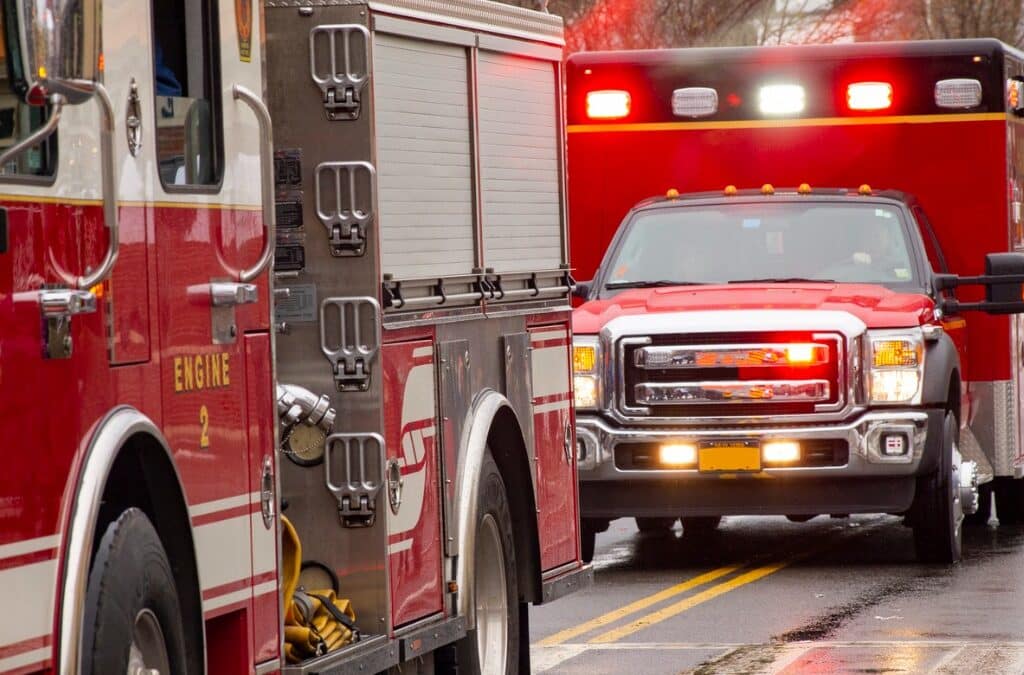Emergency vehicles come in various shapes and sizes. They all play a critical role in keeping our communities safe. Most emergency response vehicles have the authority to go faster than the speed limit or to ignore traffic signals altogether to get to where they need to be.
Emergency vehicles all have a distinct appearance that helps drivers differentiate between them from other vehicles. They also indicate the emergency in question. In this article, we will look at the various types of emergency vehicles and discuss the purposes they serve.
Police Cars
Police cars have been an indispensable instrument in the fight against crime since the dawn of the automobile age. They provide police personnel with an effective way to quickly reach emergencies, patrol the streets, investigate crimes, and apprehend offenders. Police cars are divided into various categories based on their purposes and capabilities.
- Patrol cars
- Pursuit vehicles or interceptors
- Highway patrol vehicles
- SUVs
Patrol Cars
Patrol cars are police vehicles that officers use to patrol the streets and respond to emergencies. Police departments primarily use them in metropolitan settings and use light bars and sirens to prominently mark them as law enforcement vehicles.
Pursuit Vehicles or Interceptors
Police officers use pursuit vehicles for emergencies that require high speeds. At TCS Upfitting, we typically equip pursuit vehicles with front push bars and a more powerful engine than standard patrol cars.
Highway Patrol Vehicles
Officers use highway patrol vehicles to manage traffic, ticket and apprehend speeding vehicles, and quickly respond to highway collisions. They commonly have speed cameras installed, have more power than a conventional patrol car, and are driven by highly trained officers.
SUVs
Police officers in rural areas commonly use police SUVs because of their versatility, comfort, and high performance. Thanks to modern technology and engineering, police SUVs are about as fast as patrol or response cars and come equipped with all-wheel drive.
Fire Trucks
The modern fire truck is often associated with flashing lights, screeching sirens, and a massive water cascade. The enormous size and red hue of the fire truck are among the most visible signs of a fire scene. Let’s take a look at some of the various types of fire emergency vehicles.
- Conventional fire trucks
- Fire engines
- Turntable ladder trucks
- Heavy rescue vehicles
- Quints
- A-wagons
- Water tenders
Conventional Fire Trucks
Conventional fire trucks are the most common fire trucks that drivers see and are equipped with an engine designed primarily for firefighting activities. Their goal is to transport firefighters to the scene and provide vital tools, hoses, equipment, and a limited quantity of water.
Fire Engines
Fire engines, often referred to as “pumpers,” are the first vehicles you’ll notice arriving at a fire scene. A typical fire engine has a water tank, a water pump, hundreds or even thousands of feet of powerful hoses, as well as additional materials, nozzles, and tools to ensure that the hoses perform properly. There are several types of fire engines.
Type I Fire Engines Type I fire engines carry all the necessary NFPA firefighting equipment and are specifically built to support urban, rural, and suburban departments.
Type II Fire Engines Type II fire engines are equipped with many of the same features and tools as type I fire engines but are more adaptable and commonly used for heavy-duty rescue scenarios.
Type III and Type IV Fire Engines Type III and Type IV fire engines are typically employed in rural and wildland areas and have various distinctive design and configuration elements to match the region they serve. Also called “wildland” fire engines, these vehicles are often built on a commercial 4×4 chassis and can handle off-road and diverse terrains.
Type V, Type VI, and Type VII Fire Engines Because they share similar design characteristics, Type V, Type VI, and Type VII fire engines are sometimes grouped together. These vehicles are usually pick-up trucks with four-wheel drive and a medium-duty chassis capable of carrying heavier loads than other types of fire engines.
Turntable Ladder Trucks
Turntable ladder trucks are unique vehicles that use a giant telescoping ladder to gain access to high locations. The ladder on the vehicle pivots thanks to the turntable, making it easy to spray water in the desired direction.
Heavy Rescue Vehicle
As the name implies, this vehicle has specialized equipment for technical rescue missions, which is one of the reasons why heavy rescue vehicles are frequently seen at fire scenes and in massive traffic collisions and building collapses.
Quints
Quints perform several vital roles, serve other tactical firefighting responsibilities, and maintain a constant water supply through their water tanks and pumps.
A-Wagons
A-Wagons, also known as hazardous materials apparatuses, are unique vehicles designed to combat brush and grass fires.
Water Tenders
The primary purpose of a water tender is to collect, transport, and deliver water to emergency fire scenes.
Ambulances
Ambulances are the third major classification of emergency vehicles. First responders use them to treat and transport sick or injured individuals to medical facilities. Continue reading to learn more about the different types you might see on the road.
- First responder ambulances
- Isolation ambulances
- Advanced life support ambulances
- Basic life support ambulances
- Multiple victim assistance (MVA) ambulances
- Patient transport vehicles
- Neonatal ambulances
- Bus ambulances
First Responder Ambulances
First responder ambulances are small, fast vehicles that can navigate tight locations and heavy traffic more easily than large ambulances. Patients are commonly treated and stabilized by the first responder team until ambulances with the equipment and capacity to transport individuals to a hospital arrive.
Isolation Ambulances
Isolation ambulances transport patients who require isolation due to exposure to hazardous chemicals, radiation, or highly contagious diseases. They contain sealed units with bio and chemical filters.
Advanced Life Support Ambulances
Advanced life support ambulances are sometimes referred to as mobile ICUs, as they have advanced medical equipment installed to treat a range of life-threatening diseases and critically sick patients.
Basic Life Support Ambulances
Basic life support ambulances treat people with minor medical problems and will most likely be dispatched to examine and treat patients before transporting them to a medical institution.
Multiple Victim Assistance (MVA) Ambulances
Multiple victim assistance ambulances, or MVAs, are the most common type of ambulance seen during public events (i.e., concerts, festivals, sporting events). These vehicles are more akin to first aid stations than life support vehicles for significant trauma, injuries, or illnesses.
Patient Transport Vehicles
Patient transport vehicles transport patients recovering from surgery, patients who are very frail, or cannot be transported in a regular ambulance due to injuries or medical conditions.
Neonatal Ambulances
Neonatal ambulances attend to deliveries and post-delivery needs. Neonatal ambulances also transport babies to specialized hospitals for medical treatment if they have illnesses or physical problems that arise during or after birth.
Bus Ambulances
Bus ambulances are frequently utilized at locations where earthquakes, hurricanes, building collapses, or other similar calamities have occurred where many people have been injured.
Learn More About Vehicle Upfitting with TCS Upfitting
Different emergencies require different types of equipment. From light bars to sirens to public address systems, your emergency vehicle must be well-prepared for any emergency. If you’re looking for the number one place to go for all of your emergency vehicle upfitting needs, look no further than TCS Upfitting.
We understand the value of high-quality craftsmanship, especially when it comes to emergency vehicles. We are proud to be Wichita, Kansas’s one-stop-shop for emergency vehicle upfitting. Our expert team is committed to providing you with excellent customer service from start to finish. Our number one priority is ensuring that your fleet of emergency vehicles meets your specific requirements.
To learn more about our emergency vehicle upfitting services, contact TCS Upfitting today to learn more about how we can help you with your fleet of emergency vehicles.


